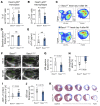Basophils balance healing after myocardial infarction via IL-4/IL-13
- PMID: 34196299
- PMCID: PMC8245180
- DOI: 10.1172/JCI136778
Basophils balance healing after myocardial infarction via IL-4/IL-13
Abstract
The inflammatory response after myocardial infarction (MI) is a precisely regulated process that greatly affects subsequent remodeling. Here, we show that basophil granulocytes infiltrated infarcted murine hearts, with a peak occurring between days 3 and 7. Antibody-mediated and genetic depletion of basophils deteriorated cardiac function and resulted in enhanced scar thinning after MI. Mechanistically, we found that basophil depletion was associated with a shift from reparative Ly6Clo macrophages toward increased numbers of inflammatory Ly6Chi monocytes in the infarcted myocardium. Restoration of basophils in basophil-deficient mice by adoptive transfer reversed this proinflammatory phenotype. Cellular alterations in the absence of basophils were accompanied by lower cardiac levels of IL-4 and IL-13, two major cytokines secreted by basophils. Mice with basophil-specific IL-4/IL-13 deficiency exhibited a similarly altered myeloid response with an increased fraction of Ly6Chi monocytes and aggravated cardiac function after MI. In contrast, IL-4 induction in basophils via administration of the glycoprotein IPSE/α-1 led to improved post-MI healing. These results in mice were corroborated by the finding that initially low counts of blood basophils in patients with acute MI were associated with a worse cardiac outcome after 1 year, characterized by a larger scar size. In conclusion, we show that basophils promoted tissue repair after MI by increasing cardiac IL-4 and IL-13 levels.
Keywords: Cardiology; Cardiovascular disease; Heart failure; Innate immunity.
Conflict of interest statement
Figures








Comment in
-
Healing and repair after myocardial infarction: the forgotten but resurgent basophil.J Clin Invest. 2021 Jul 1;131(13):e150555. doi: 10.1172/JCI150555. J Clin Invest. 2021. PMID: 34196301 Free PMC article.
-
Basophils promote healing after MI.Nat Rev Cardiol. 2021 Oct;18(10):687. doi: 10.1038/s41569-021-00604-6. Nat Rev Cardiol. 2021. PMID: 34285416 No abstract available.
References
-
- Horckmans M, et al. Neutrophils orchestrate post-myocardial infarction healing by polarizing macrophages towards a reparative phenotype. Eur Heart J. 2017;38(3):187–197. - PubMed
Publication types
MeSH terms
Substances
Grants and funding
LinkOut - more resources
Full Text Sources
Medical
Molecular Biology Databases

